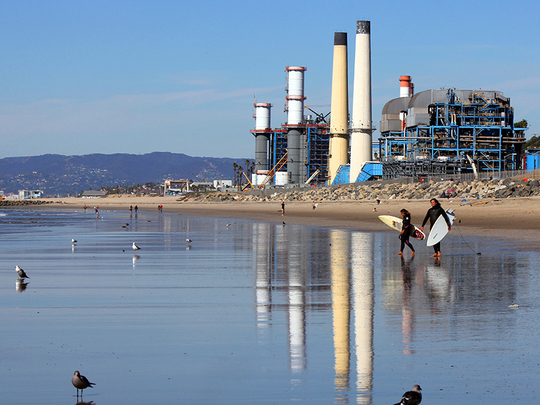
Washington: President Donald Trump will take the most significant step yet in obliterating his predecessor’s environmental record Tuesday, instructing federal regulators to rewrite key rules curbing US carbon emissions.
The sweeping executive order also seeks to lift a moratorium on federal coal leasing and remove the requirement that federal officials consider the impact of climate change when making decisions.
The order sends an unmistakable signal that just as President Barack Obama sought to weave climate considerations into every aspect of the federal government, Trump is hoping to rip that approach out by its roots.
“This policy is in keeping with President Trump’s desire to make the United States energy independent,” said a senior administration official who briefed reporters on the directive Monday evening and asked for anonymity to speak in advance of the announcement. “When it comes to climate change, we want to take our course and do it in our own form and fashion.”
Some of the measures could take years to implement and are unlikely to alter broader economic trends that are shifting the nation’s electricity mix from coal-fired generation to natural gas and renewables. The order is silent on whether the United States should withdraw from the 2015 Paris climate agreement, under which it has pledged to cut its greenhouse gas emissions between 26 and 28 per cent by 2025 compared to 2005 levels, because the administration remains divided on that question.
The order comes after several moves by Trump to roll back Obama-era restrictions on mining, drilling and coal- and gas-burning operations. In his first two months as president, Trump has nullified a regulation barring surface-mining companies from polluting waterways and set aside a new accounting system that would have compelled coal companies and other energy firms to pay more in federal royalties.
The administration also has announced it will reconsider stricter fuel-efficiency standards for cars and light trucks and has approved two major oil pipelines, Dakota Access and Keystone XL, that Obama had halted.
Accelerating fossil-fuel production on federal lands and sidelining climate considerations could lead to higher emissions of the greenhouse gases driving climate change and complicate a global effort to curb the world’s carbon output. But Trump has repeatedly questioned whether climate change is underway and emphasised that he is determined to deliver for the voters in coal country who helped him win the Oval Office.
“He’s made a pledge to the coal industry and he’s going to do whatever he can to help those workers,” the senior administration official said.
US coal jobs, which number about 75,000, have been declining for decades. The official did not predict how many jobs might be spurred by this shift in policy.
The centrepiece of the new presidential directive, telling the Environmental Protection Agency to begin rewriting the 2015 regulation that limits greenhouse-gas emissions from existing power plants, will trigger a laborious rule making process and a possible legal fight.
The agency must first get permission from the US Court of Appeals for the D.C. Circuit, where the rule is tied up in litigation, to revisit the matter. Then, agency officials will have to justify reaching the opposite conclusion of the Obama EPA, which argued it was technically feasible and legally warranted to reduce carbon pollution by about one-third by 2030, compared with 2005 levels.
“So, for the president, even if he would like to revoke the Clean Power Plan, he doesn’t have legal authority to do that,” said Jeffrey Holmstead, a partner at the Bracewell law firm who opposes the Obama-era rule. Holmstead, who headed the EPA’s air and radiation office under President George W. Bush, said he thinks the agency can justify reversing the regulation. But “they have to justify why they have changed,” he added.
While environmental groups decried Trump’s move, mining officials welcomed it as an important course correction in federal energy policy.
“This rule was an unlawful attempt to radically transform the nation’s power grid, destroying valuable energy assets and leaving our economy more vulnerable to rising power prices — all for an insignificant environmental benefit,” said Hal Quinn, president and chief executive of the National Mining Association.
Environmentalists vowed to fight the executive order in court and press ahead with their goals on the state level.
David Doniger, director of the Natural Resources Defense Council’s climate and clean-air program, said unwinding the Clean Power Plan will not happen quickly, no matter what the president wants. “Tearing the rules down require going through the same process it took to build them up,” Doniger said. “We will make them face the music at every step.”
Christopher Field, a professor at Stanford University’s Wood Institute for the Environment, said in an email that the directive carries long-term risks, rather than immediate ones. “Some are risks from eroding the position of US companies in the clean energy sector,” Field said. “Others are from the loss of irreplaceable natural heritage that is put in jeopardy by ill-conceived policies.”
The president will also instruct the Interior Department to rewrite a 2015 rule, currently stayed in court, that imposes restrictions on hydraulic fracturing on federal and tribal lands. The directive will also make it easier to flare methane in oil and gas operations on federal land, by triggering the review of a rule the Interior Department finalised in November.












